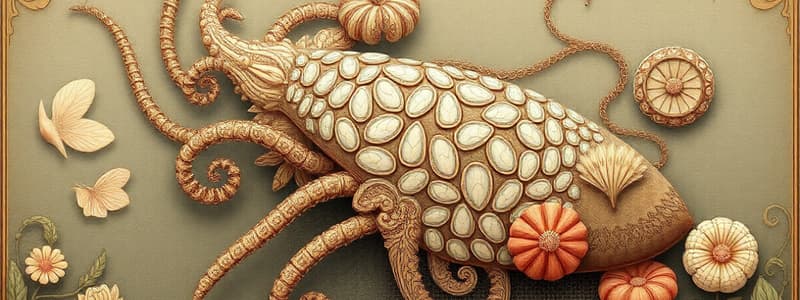Podcast
Questions and Answers
Which of the following characteristics differentiates cephalopods from gastropods and bivalves?
Which of the following characteristics differentiates cephalopods from gastropods and bivalves?
- Dependence on external shells for protection.
- Inhabitation of marine environments.
- Presence of a larval stage such as trochophore.
- Use of jet propulsion for movement. (correct)
A marine biologist discovers a new species of mollusk with two hinged shells and no distinct head. Which feeding strategy would be most likely for this new species?
A marine biologist discovers a new species of mollusk with two hinged shells and no distinct head. Which feeding strategy would be most likely for this new species?
- Grazing on algae with a radula.
- Filter feeding using gills. (correct)
- Scavenging for decaying organic matter.
- Predatory hunting with tentacles.
A researcher is studying a population of bivalves and notices a sharp decline. The water's pH is measured to be 4.5. What is the most likely cause of the population decline?
A researcher is studying a population of bivalves and notices a sharp decline. The water's pH is measured to be 4.5. What is the most likely cause of the population decline?
- The acidic water dissolving the bivalves' shells. (correct)
- A new predator introduced into the ecosystem.
- Increased competition for food resources.
- Overpopulation leading to starvation.
A student is comparing the respiratory systems of different gastropods. What adaptation would they expect to find in a land-dwelling gastropod that is NOT typically found in marine gastropods?
A student is comparing the respiratory systems of different gastropods. What adaptation would they expect to find in a land-dwelling gastropod that is NOT typically found in marine gastropods?
If a mollusk possesses a well-developed head with tentacles and complex image-forming eyes, to which class does it most likely belong?
If a mollusk possesses a well-developed head with tentacles and complex image-forming eyes, to which class does it most likely belong?
How does the feeding strategy of bivalves primarily differ from that of cephalopods?
How does the feeding strategy of bivalves primarily differ from that of cephalopods?
What is the primary function of the ink sac in cephalopods like squids and octopuses?
What is the primary function of the ink sac in cephalopods like squids and octopuses?
Which characteristic is NOT universally observed across all species within the Phylum Mollusca?
Which characteristic is NOT universally observed across all species within the Phylum Mollusca?
How does the mantle contribute to the survival or functioning of mollusks?
How does the mantle contribute to the survival or functioning of mollusks?
How does the circulatory system differ between squids and most other mollusks, and what advantage does this provide?
How does the circulatory system differ between squids and most other mollusks, and what advantage does this provide?
What is the primary function of the radula in mollusks that possess one?
What is the primary function of the radula in mollusks that possess one?
If a newly discovered marine invertebrate has a soft body, a mantle cavity with gills, and a hemocoel, to which phylum would it most likely belong?
If a newly discovered marine invertebrate has a soft body, a mantle cavity with gills, and a hemocoel, to which phylum would it most likely belong?
How does the mantle cavity support gas exchange in terrestrial mollusks?
How does the mantle cavity support gas exchange in terrestrial mollusks?
What is the hemolymph's primary role in mollusks with an open circulatory system?
What is the hemolymph's primary role in mollusks with an open circulatory system?
Which of the following best explains the evolutionary advantage of having a shell in many molluscan species?
Which of the following best explains the evolutionary advantage of having a shell in many molluscan species?
Flashcards
Veliger Larva
Veliger Larva
A larval stage in mollusks that develops after the trochophore stage in many species.
Gastropoda
Gastropoda
The largest class of mollusks, generally characterized by a well-developed head and a muscular foot for crawling.
Pulmonate Gastropods
Pulmonate Gastropods
Having a lung-like structure in their mantles, allowing them to live on land.
Bivalvia
Bivalvia
Signup and view all the flashcards
Adductor Muscles (in Bivalves)
Adductor Muscles (in Bivalves)
Signup and view all the flashcards
Cephalopoda
Cephalopoda
Signup and view all the flashcards
Ink Sac (in Cephalopods)
Ink Sac (in Cephalopods)
Signup and view all the flashcards
What are Mollusks?
What are Mollusks?
Signup and view all the flashcards
Mollusk Shell
Mollusk Shell
Signup and view all the flashcards
Mantle (Mollusk)
Mantle (Mollusk)
Signup and view all the flashcards
Mantle Cavity
Mantle Cavity
Signup and view all the flashcards
Mollusk Foot
Mollusk Foot
Signup and view all the flashcards
Visceral Mass
Visceral Mass
Signup and view all the flashcards
Radula
Radula
Signup and view all the flashcards
Hemocoel
Hemocoel
Signup and view all the flashcards
Study Notes
- Mollusks are invertebrates with soft bodies belonging to the Phylum Mollusca.
- Phylum Mollusca is the second-largest phylum after Phylum Arthropoda.
- Most mollusks live in marine environments, but some inhabit freshwater and land.
- Phylum Mollusca contains over 80,000 species that are herbivores, parasites, or predators.
Mollusk Characteristics
- Mollusks usually protect their soft bodies with a calcium carbonate shell that can be external or reduced internal shells.
- They have a fleshy cloak called a mantle that wraps around the body and secretes the shell on the outer surface.
- Aquatic mollusks have gills in the mantle cavity for gaseous exchange, while land-dwelling mollusks have a lung-like space.
- Mollusks have a large, flat muscular foot for locomotion.
- Viscera, or body organs, are located above the foot in a concentrated mass.
- Some mollusks have a radula, which is a belt of teeth resembling a rasp tool, in their mouth.
- The body space containing blood is referred to as a hemocoel, and mollusks also have a coelom (body cavity).
- Some mollusks have an open circulatory system with hemolymph, while others like squids have a closed circulatory system.
- Mollusks possess digestive, circulatory, respiratory, excretory, reproductive, and nervous systems.
- The larval stage, called trochophore, is similar in all mollusks, developing into a veliger larva in many species.
Types of Mollusks
- Mollusks are classified into Gastropoda, Bivalvia, Cephalopoda, and Polyplacophora (chitons).
- The three major groups of mollusks are gastropods, cephalopods, and bivalves.
Gastropods
- Gastropods belong to the class Gastropoda, the largest class of mollusks, with over 70,000 species.
- Gastropods are primarily found in marine areas, freshwater, or on land and have a well-developed head with tentacles.
- Gastropods use their muscular foot for crawling.
- Most gastropods have a spirally coiled external shell, while others have a flattened shell or no shell.
- Land-dwelling gastropods with a lung-like structure in their mantles are called pulmonates.
- Snails and slugs are examples of gastropods.
Bivalves
- Bivalves belong to the class Bivalvia, with approximately 10,000 species.
- They mainly inhabit fresh and marine waters with a pH above 5.
- Bivalves have two hinged shells (valves) connected by a flexible ligament.
- An adductor muscle keeps the valves tightly closed for protection.
- Bivalves are filter feeders, using gills to collect food and they have no head.
- Examples of bivalves include clams, scallops, mussels, and oysters.
Cephalopods
- Cephalopods belong to the class Cephalopoda and include approximately 650 species.
- Cephalopods are primarily predators or scavengers.
- They have a funnel in their mantle that produces jet propulsion movement.
- The mouth is surrounded by 8 to 90 arms or tentacles with suckers for catching prey.
- Cephalopods have well-developed eyes that can form images.
- They can change body color and produce a thick black liquid from their ink sac to avoid predation.
- Examples of cephalopods include the squid, octopus, nautilus, and cuttlefish.
Mollusk Examples
-
Snails
- Belong to the Class Gastropoda.
- They have an external shell, such as a conch shell.
- Land snails are pulmonate.
-
Octopus
- Belong to Class Cephalopoda.
- Have eight arms with suckers surrounding their mouth.
- They also have complex eyes.
-
Oysters
- Belong to Class Bivalvia.
- They have two hinged shells.
- They are mainly filter feeders.
Studying That Suits You
Use AI to generate personalized quizzes and flashcards to suit your learning preferences.



